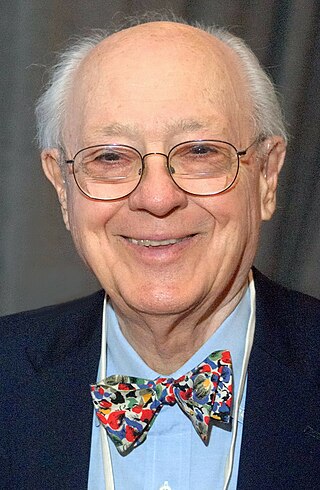
John Adam Presper Eckert Jr. was an American electrical engineer and computer pioneer. With John Mauchly, he designed the first general-purpose electronic digital computer (ENIAC), presented the first course in computing topics, founded the Eckert–Mauchly Computer Corporation, and designed the first commercial computer in the U.S., the UNIVAC, which incorporated Eckert's invention of the mercury delay-line memory.

John William Mauchly was an American physicist who, along with J. Presper Eckert, designed ENIAC, the first general-purpose electronic digital computer, as well as EDVAC, BINAC and UNIVAC I, the first commercial computer made in the United States.

Charles William Bachman III was an American computer scientist, who spent his entire career as an industrial researcher, developer, and manager rather than in academia. He was particularly known for his work in the early development of database management systems. His techniques of layered architecture include his namesake Bachman diagrams.

Guion Stewart Bluford Jr. is an American aerospace engineer, retired United States Air Force (USAF) officer and fighter pilot, and former NASA astronaut, in which capacity he became the first African American to go to space. While assigned to NASA, he remained a USAF officer rising to the rank of colonel. He participated in four Space Shuttle flights between 1983 and 1992. In 1983, as a member of the crew of the Orbiter Challenger on the mission STS-8, he became the first African American in space as well as the second person of African descent in space, after Cuban cosmonaut Arnaldo Tamayo Méndez.
John R. Mashey is an American computer scientist, director and entrepreneur.

Sadie Tanner Mossell Alexander was a pioneering Black professional and civil rights activist of the early-to-mid-20th century. In 1921, Mossell Alexander was the second African-American woman to receive a Ph.D. and the first one to receive one in economics in the United States. In 1927, she was first Black woman to receive a law degree from the University of Pennsylvania Law School and went on to become the first Black woman to practice law in the state. She was also the first national president of Delta Sigma Theta sorority, serving from 1919 to 1923.

Sankar Kumar Pal is a computer scientist and president of the Indian Statistical Institute, Kolkata. He is a computer scientist with an international reputation on pattern recognition, image processing, fuzzy neural network, soft computing, granular mining, and machine intelligence. He founded the Machine Intelligence Unit in 1993, and the Center for Soft Computing Research: A National Facility in 2004, both at the ISI. He is the founder president of the Indian National Academy of Engineering, Kolkata Chapter.
Harlan D. Mills was Professor of Computer Science at the Florida Institute of Technology and founder of Software Engineering Technology, Inc. of Vero Beach, Florida. Mills' contributions to software engineering have had a profound and enduring effect on education and industrial practice. Since earning his Ph.D. in Mathematics at Iowa State University in 1952, Mills led a distinguished career.

Frances Elizabeth Holberton was an American computer scientist who was one of the six original programmers of the first general-purpose electronic digital computer, ENIAC. The other five ENIAC programmers were Jean Bartik, Ruth Teitelbaum, Kathleen Antonelli, Marlyn Meltzer, and Frances Spence.
The Institute for Defense Analyses (IDA) is an American non-profit corporation that administers three federally funded research and development centers (FFRDCs) – the Systems and Analyses Center (SAC), the Science and Technology Policy Institute (STPI), and the Center for Communications and Computing (C&C) – to assist the United States government in addressing national security issues, particularly those requiring scientific and technical expertise. It is headquartered in Alexandria, Virginia.
Black Data Processing Associates (BDPA) is an American non-profit organization that serves the professional well-being of African Americans and other minorities working within technology. BDPA provides resources that support the professional growth and technical development of minority individuals in the information technology industry. Through education and leadership, BDPA promotes innovation, business skills, and professional development. The organization has over 50 chapters throughout the United States. BDPA National headquarters is located in Largo, Maryland.
Joseph S. Francisco is an American scientist and the former president of the American Chemical Society from 2009 to 2010. He currently serves as the President's Distinguished Professor of Earth and Environmental Science and professor of chemistry at the University of Pennsylvania. He served as the Dean of College of Arts and Sciences, Elmer H. and Ruby M.Cordes Chair in chemistry at University of Nebraska in Lincoln until 2018.

Henrique "Rico" S. Malvar is a distinguished Brazilian engineer and a signal processing researcher at Microsoft Research's largest laboratory in Redmond, Washington, United States. He was the managing director of the lab following the departure of long-time Managing Director Dan Ling in 2007, when he oversaw about 350 researchers. He was a Distinguished Engineer at Microsoft for over 15 years. He retired from Microsoft in January 2023, and later received the title of Microsoft Emeritus Researcher.
Walter Cooper is an American scientist, humanitarian, activist, and educator. Primarily a research scientist, he was also heavily involved in civil rights work both in Rochester, New York and in Mali.

Valerie L. Thomas is an American data scientist and inventor. She invented the illusion transmitter, for which she received a patent in 1980. She was responsible for developing the digital media formats that image processing systems used in the early years of NASA's Landsat program.
The following outline is provided as an overview of and topical guide to software development:

John Henry Clippinger III is a researcher, entrepreneur, and activist around decentralized, autonomous, self-organizing systems with a focus on generative governance and finance for climate change and social equity.
Boon Thau Loo is a Singaporean-American computer scientist, college administrator, and technology entrepreneur. He is currently the RCA professor in the Computer and Information Science department at the University of Pennsylvania where he leads a research lab working on distributed systems, and serves as the Associate Dean for Graduate Programs at the University of Pennsylvania School of Engineering and Applied Science.









